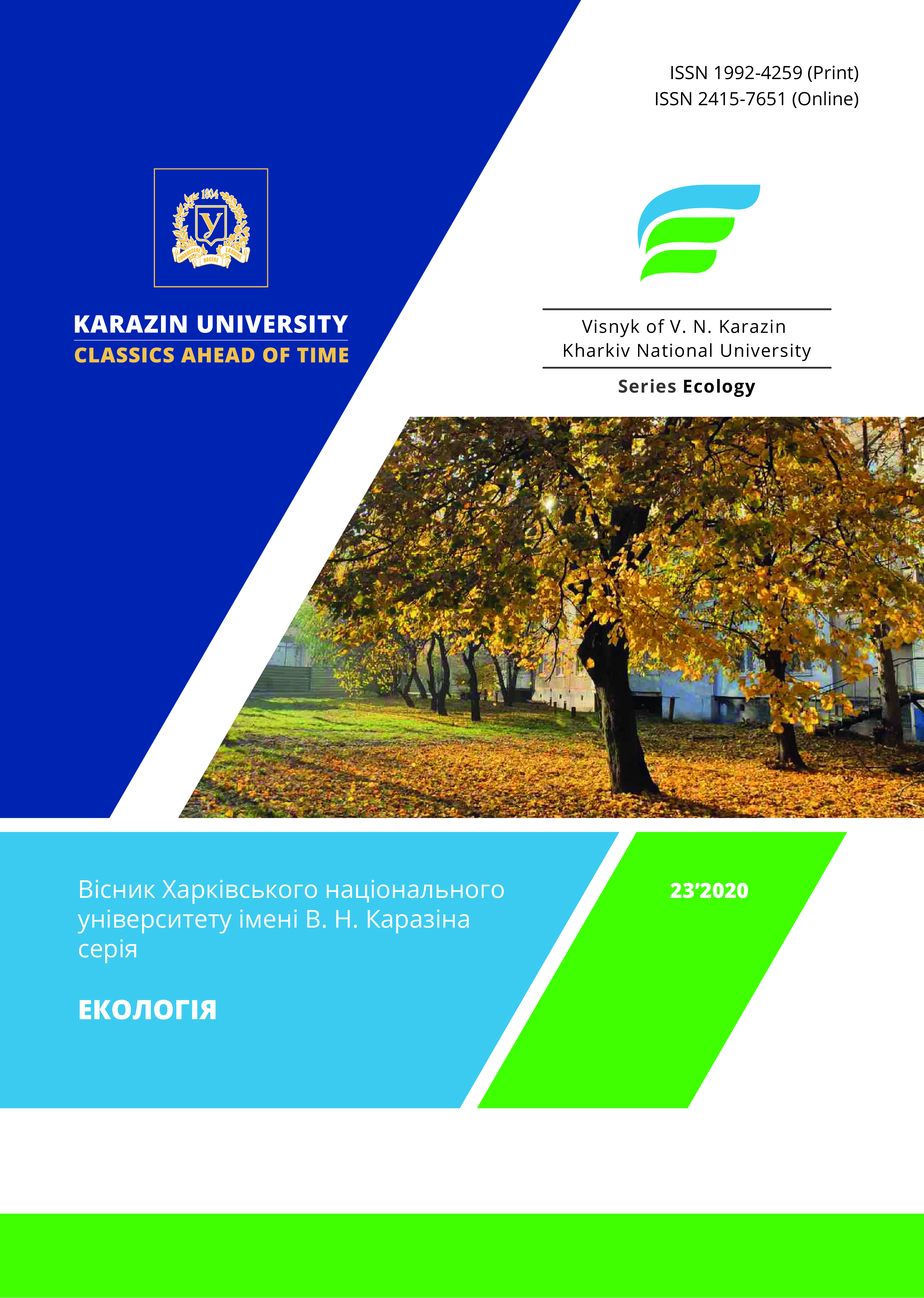Пластик твердих побутових відходів прибережної зони північно-західного Причорномор’я як складова морського сміття
Анотація
Мета. Оцінка масштабів утворення пластикових відходів в прибережній зоні Північно-Західного Причорномор’я та їх можливої ролі у формуванні морського сміття в акваторії Чорного моря.
Методи. Методологічною основою роботи є системний аналіз.
Результати. Щорічні обсяги у твердих побутових відходів у Північно-Західному Причорномор’ї можуть досягати 2,5 млн т/рік, а обсяги утворення відходів пластикових матеріалів – до 323 тис. т /рік. Незважаючи на ресурсну цінність пластикових відходів, натепер не існує визначеної системи поводження з ними і за цих умов вони видаляються на численні звалища (у тому числі, на несанкціоновані) твердих побутових відходів. Значна частина пластику (до 80%) із неорганізованих звалищ та інших берегових джерел забруднення виноситься повітряними і водними потоками в акваторію північно-західної частини Чорного моря. Визначено, що 83% морського сміття, виявленого в Чорному морі, становить пластик. В свою чергу, наявність морського сміття обумовлено недосконалістю системи поводження з твердими побутовими відходами. Домінуючим способом поводження з ними залишається їх вивезення і захоронення на сміттєзвалищах. Станом на 2019 рік в Одеській області налічувалося 528 звалищ, в Миколаївській області – 267, в Херсонській – 54. Майже 17% звалищ в Одеській області і 26% в Миколаївській області не відповідають нормам екологічної небезпеки. Значна частина пластикових відходів, насамперед, із несанкціонованих звалищ твердих побутових відходів, повітряними потоками виноситься в річкову мережу, а у випадку близькості їх до прибережної смуги – безпосередньо в акваторію Чорного моря. Пластикові відходи виносяться з водозборів великих річок (Дунаю, Дністра, Південного Бугу і Дніпра), а також водозборів численних середніх і малих річок. Практично вся берегова смуга Північно-Західного Причорномор’я активно використовується в рекреаційних цілях і, отже, є джерелом формування пляжного сміття. Крім того, береговими джерелами надходження сміття можуть бути населені пукти, морегосподарські комплекси та сільськогосподарські угіддя, що розташовані вздовж прибережної смуги. Незначна частка пластикових відходів утворюється в межах морської акваторії (за рахунок судноплавства, рибальства тощо).
Висновки. Основною складовою морського сміття є пластик, оскільки на нього припадає 83% морського сміття, виявленого в Чорному морі. Макропластик може піддаватися тривалому переміщенню морськими течіями, вітрами, хвилями та становити пряму загрозу морській екосистемі. Напрями переміщення морського сміття залежать від генеральної циркуляції у поверхневому шарі Чорного моря. Процеси біодеградації макропластика утруднені в умовах морського середовища, а тому його трансформація обмежується процесами деструкції і диспергуванням до мікро- і наночастинок. Ураховуючи екологічну небезпеку мікропластику доцільно створити систему спостережень за його вмістом в морському середовищі. Для поліпшення екологічної ситуації в прибережній зоні Північно-Західного Причорномор’я необхідно істотно збільшити обсяги пластикових відходів, що утилізуються, а також ліквідувати чисельні звалища твердих побутових відходів, які не відповідають вимогам екологічної безпеці.
Завантаження
Посилання
Plastic waste and microplastics in the oceans. A global warning and study, a call to action, and guidance for policy change. (2016). Nairobi. UNEP. Retrieved October 7, 2020, from https://wedocs.unep.org/bitstream/handle/20.500.11822/7720/MPDMP_RU.pdf?sequence=4&isAllowed=y (In Russian).
Surveys in Georgia, Russian Federation and Ukraine, 2017. Draft Final Scientific Report. November (2018). Retrieved October 7, 2020, from http://emblasproject.org/wp-content/uploads/2019/07/EMBLAS-II_NPMS_JOSS_2017_ScReport_FinDraft2.pdf
National Waste Management Strategy in Ukraine until 2030. (2017). Approved by the order of the Cabinet of Ministers of Ukraine of November 8, 2017 N 820. Retrieved September 21, 2020, from http://zakon2.rada.gov.ua/laws/show/820-2017-р (In Ukraine).
The state of the sphere of household waste management in Ukraine in 2019. (2020). Retrieved October 7, 2020, from https://www.minregion.gov.ua/napryamki-diyalnosti/zhkh/terretory/stan-sfery-povodzhennya-z-pobutovymy-/ (In Ukraine).
Municipal solid waste in Ukraine: development potential. Scenarios for the development of the solid waste management industry. (2015). Kyiv: IFC, World Bank Group. Retrieved October 3, 2020, from https://www.ifc.org/wps/wcm/connect/504c5765-89d4-4be1-916e-ea27aa94feaf/22.+%D0%A2%D0%B2%D0%B5%D1%80%D0%B4%D1%96+%D0%BF%D0%BE%D0%B1%D1%83%D1%82%D0%BE%D0%B2%D1%96+%D0%B2%D1%96%D0%B4%D1%85%D0%BE%D0%B4%D0%B8+%D0%B2+%D0%A3%D0%BA%D1%80%D0%B0%D1%97%D0%BD%D1%96+%D0%9F%D0%9E%D0%A2%D0%95%D0%9D%D0%A6%D0%86%D0%90%D0%9B+%D0%A0%D0%9E%D0%97%D0%92%D0%98%D0%A2%D0%9A%D0%A3+%D0%A1%D1%86%D0%B5%D0%BD%D0%B0%D1%80%D1%96%D1%97+%D1%80%D0%BE%D0%B7%D0%B2%D0%B8%D1%82%D0%BA%D1%83+%D0%B3%D0%B0%D0%BB%D1%83%D0%B7%D1%96+%D0%BE%D0%B2%D0%BE%D0%B4%D0%B6%D0%B5%D0%BD%D0%BD%D1%8F+.pdf?MOD=AJPERES&CVID=lNpI3Ew (In Ukraine).
Matveev, Y.B., & Geletukha, G.G. (2019). Prospects of energy utilisation of municipal solid waste in Ukraine. UABio Position Paper № 22. Retrieved October 3, 2020, from https://uabio.org/wp-content/uploads/2020/01/position-paper-uabio-22-ua.pdf (In Ukraine).
https://uabio.org/wp-content/uploads/2020/01/position-paper-uabio-22-en.pdf (In English)
Generation and utilization of waste by materials. Archive. State Statistics Service of Ukraine, 1998-2015. Retrieved October 3, 2020, from http://www.ukrstat.gov.ua/operativ/operativ2013/ns_rik/ns_u/arch_utvut_u.htm (In Ukraine).
Shanina, T.P., Seifullina, I.Y. & Kushnireva, V.O. (2015). Ecological and economic substantiation of the choice of the method of plastic waste management. Odesa National University Herald. Chemistry, 20 (2 (54)), 49-60. https://doi.org/10.18524/2304-0947.2015.2(54).50628 (In Ukraine).
Zobkov M.B. & Esyukova E.E. (2018). Microplastics in the marine environment: a review of methods for sampling, preparation and analysis of water samples, bottom sediments and coastal sediments. Oceanology, 58 ( 1), 149-157. https://doi.org/10.7868/S0030157418010148 (In Russian).
Kostianoy, A.G. & Kosarev, A.N. (Eds.) (2008). The Black Sea Environment. The handbook of environmen-tal. Chemistry5ˑQ. Springer-Verlag Berlin Heidelberg.
Автори, які публікуються у цьому журналі, погоджуються з наступними умовами:
- Автори залишають за собою право на авторство своєї роботи та передають журналу право першої публікації цієї роботи на умовах ліцензії Creative Commons Attribution License 4.0 International (CC BY 4.0), котра дозволяє іншим особам вільно розповсюджувати опубліковану роботу з обов'язковим посиланням на авторів оригінальної роботи та першу публікацію роботи у цьому журналі.
- Автори мають право укладати самостійні додаткові угоди щодо неексклюзивного розповсюдження роботи у тому вигляді, в якому вона була опублікована цим журналом (наприклад, розміщувати роботу в електронному сховищі установи або публікувати у складі монографії), за умови збереження посилання на першу публікацію роботи у цьому журналі.
- Політика журналу дозволяє і заохочує розміщення авторами в мережі Інтернет (наприклад, у сховищах установ або на особистих веб-сайтах) рукопису роботи, як до подання цього рукопису до редакції, так і під час його редакційного опрацювання, оскільки це сприяє виникненню продуктивної наукової дискусії та позитивно позначається на оперативності та динаміці цитування опублікованої роботи (див. The Effect of Open Access).





